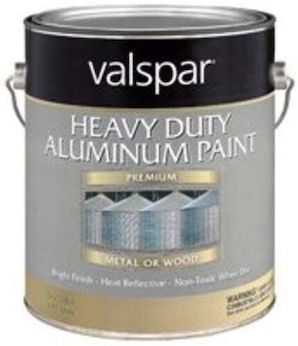
Curated with aloha by
Ted Mooney, P.E. RET

The authoritative public forum
for Metal Finishing 1989-2025

-----
"Aluminium paint" applications and issues
Q. I'm refinishing a bathroom cabinet with Rustoleum aluminum paint. I want to apply a clear coating over the paint. I would like to have a high gloss finish. I tried lacquer, didn't work too well. I wasn't happy with results. Any suggestions? I realize this may not be the right place to ask but I haven't found another place to ask. Any help would be appreciated. Thank you.
Charlotte Davis- Las Vegas, Nevada
February 4, 2022
A. Hi Charlotte. In my very limited experience, aluminum paint has been an excellent 'stain stopper' -- blocking rust stains better than the typical white primers. But if you are looking for a shiny metallic look, I think there are better approaches than aluminum paint followed by a clear coat. I'd look to Rustoleum or Krylon 'metallic' paints.
Luck & Regards,

Ted Mooney, P.E. RET
Striving to live Aloha
finishing.com - Pine Beach, New Jersey
February 2022
⇩ Related postings, oldest first ⇩
Q. I am in automobile industry and we are doing heat resistant aluminium paint on silencers [mufflers]. We regularly observe paint peel-off problems in form of blisters when the vehicle is started at the silencer gets heated. We do degreasing followed by phosphating then rinsing, drying and then two coats of aluminum paint are applied.
Kindly let us what's wrong in the process or what precautions are to be taken while operation to avoid such peel-offs?
Regards,
Rajeev sharma- Lucknow, India
2001
A. Phosphate or chromate pre-treatments turn to powder at elevated temperatures. That is why you are losing adhesion. High Temperature coatings should be applied directly to the cleaned metal surface immediately after cleaning before oxidation can take place.
Don Brenner- Lake Buena Vista, Florida, USA
2001
Mixing aluminum paint with varathane for hard glaze coat
Q. Greetings,
I am looking for a suggestion actually. I am refinishing a metal surface and am attempting to faux finish it with an aluminum paint. It is petroleum based. Can I mix an oil base glaze with this material to get a medium suitable for the finish? If not can I use some other material on it that will cause an interesting resist technique that will still be long lasting. If not can I put a urethane or lacquer then over it.
Thanks for your help,
M Berns- Pittsburgh, Pennsylvania
2002
A. Regarding your aluminum coating, you can mix it with non-fiber foundation coating and some varathane to give it a hardened finish; make sure that you mix your paint and foundation coating two to one and you're good to go.
Mike McMurray- Lawrenceville, Georgia
2005
Aluminum paint as a vapor barrier
Q. Does "aluminum paint" have a permeability rating and, if so, can it be applied to surfaces such as extruded polystyrene (SM Board by Dow Chemical)?
WARREN WALKERconstruction company - MISSISSAUGA, ONTARIO, CANADA
2003
Q. Is there a paint the OBC will accept as a vapor barrier where the normal poly was omitted in a new wall for a commercial building?
If so can you give us the details as well as the relevant text in the OBC permitting it or a case history?
- Markhma, Ontario, Canada
June 7, 2008
Why does aluminum paint lose its leafing property?
Q. We make an Aluminium Paint based on hydrocarbon resin for dipping poles and fences with Vis. 10" FC4. But every few weeks we find a problem of texture -- it's not consistent. Aluminum content is 8-9% and aromatic solvent 72%. We supply it in one-pack. A rejected lot 3-4 months older gives no shine and turns greyish, losing its LEAFING properties.
Any additives or remedial measures? Please help.
Nikunj P. Patelsupplier - V.V.Nagar, Guj, India
2005
Trying to color aluminum paint by anodize and dyeing the flakes
Q. We're looking for a way to add bold colors to our aluminum paint. Dye isn't strong enough when we just add it to the solvent in the paint. I was wondering if anyone here could tell me if it was possible to anodize the flakes and then dye them directly? It seems like it should be possible - if I pumped the flake dispersion through small enough pipes with an electrode wire on the inside, I ought to be able to get somewhere - what do you folks think?
Bob Zonisbuyer/developer - Murfreesboro, Tennessee, USA
May 5, 2009
A. Beware ... as I believe you are on your way to constructing a "Pipe Bomb".
Terry HicklingBirmingham, United Kingdom
June 22, 2009
June 22, 2009
Hi, Terry. What is the explosion hazard that you foresee?
Regards,

Ted Mooney, P.E.
Striving to live Aloha
finishing.com - Pine Beach, New Jersey
A. Aluminum is a more reactive metal than most give it credit to, and hydrolyzes rather rapidly, giving off hydrogen gas.
If you attempt to go about it using nitric or caustic for oxidizing and desmutting, you're creating a safety hazard.
If you're trying to make aluminum oxide flakes aluminum, an electrochemical process seems as though it would be rather tedious for what the end result is.
If you run super-heated steam over them, they'll form a nice oxide layer in no time, and without the explosion hazards Mr. Hickling was alluding to.
- Toledo, Ohio
July 28, 2009
A. I doubt it since the paint is an insulator and you need excellent contact for anodizing.
You might be able to anodize and dye the aluminum before it is mixed into the paint, but I really do not think that this is a viable process for over 99% of shops.
- Navarre, Florida
June 22, 2009
Q, A, or Comment on THIS thread -or- Start a NEW Thread
